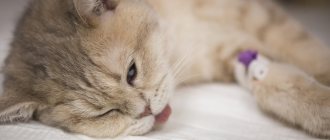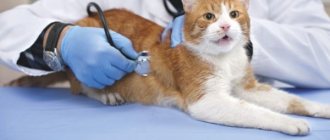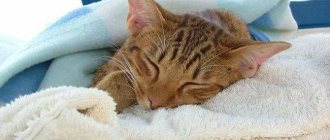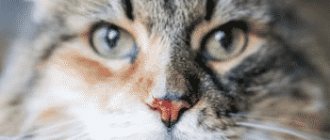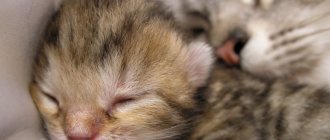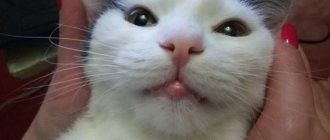Other complications of pregnancy in cats (dangerous)
1) Uterine bleeding in cats
is characterized by copious discharge of blood and blood clots from the cat’s vulva.
Causes of uterine bleeding in cats: trauma, exposure to pathogenic microorganisms on the placenta.
As a rule, uterine bleeding provokes or is a sign of miscarriage in cats; but with timely veterinary intervention, a cat’s pregnancy can be saved.
2) Torsion of the uterus in a cat
There is a twisting, twisting, bending, bending of one of the “horns” of the uterus (the cat’s uterus is bicornuate, i.e. has the shape of the letter Y).
Causes of uterine torsion in cats: trauma.
Leads to intrauterine death of the fetus(es) without miscarriage and removal of the uterus; with timely veterinary intervention, and if torsion occurs late in pregnancy, kittens can be removed by caesarean section.
3) Ectopic pregnancy of a cat
An ectopic pregnancy in a cat is primary - the fetuses immediately begin to develop outside the uterus; and secondary - the fetuses develop outside the uterus due to its rupture.
Causes of ectopic pregnancy in cats: unknown (primary ectopic pregnancy); trauma, pathology of the uterus/oviducts, etc. (primarily thinning of their walls, leading to ruptures, with secondary ectopic).
In all cases, it leads to the death of the fetus and its surgical removal; in the absence of timely surgical intervention, sepsis and necrosis develop, which can lead to the removal of some of the cat’s internal organs or to its death. Happens extremely rarely.
4) Post-term pregnancy with a cat
It is characterized by the absence of labor in a cat after the 70th day of pregnancy.
Reasons for post-term pregnancy with a cat: intrauterine fetal death, large fetal size, large number of fetuses, hormonal imbalance; pathology of the cat’s reproductive tract (narrow pelvis, etc.)
Post-term pregnancy with a cat usually results in a cesarean section with removal of the fetus (live or dead).
If timely surgical intervention does not affect the cat’s health in any way; if untimely - sepsis, necrosis, death of the cat.
Complications leading to miscarriage
Pregnant cats sometimes experience various complications, which, although not always leading to miscarriage, do increase the risk of miscarriage.
Damage to the uterus
The uterus in cats has two peculiar “horns” (it is somewhat reminiscent of the English Y), and damage to at least one of them (twisting, fracture, mainly caused by injuries, for example, when meeting a dog) results in a miscarriage in the cat. Kittens with such injuries can be saved only in late stages of pregnancy, using a caesarean section.
Internal bleeding
A large amount of blood released from the cat’s uterus also often leads to the loss of offspring or directly accompanies a miscarriage. However, pregnancy can be saved if you consult a veterinarian in time.
Ectopic pregnancy
This is the rarest, but most dangerous cause of miscarriage in cats. Ectopic pregnancy can be primary (fetuses develop outside the uterus from the very beginning) or secondary (due to damage/rupture of the uterus). In one hundred percent of cases it leads to the death of the offspring, and in the presence of complications, to the death of the mother.
False pregnancy in cats
False pregnancy in cats is a psychosomatic condition of a cat in which it feels pregnant and behaves accordingly.
Causes of false pregnancy in cats: ovulation without fertilization, which occurred as a result of unsuccessful mating or artificial stimulation of ovulation without subsequent mating.
False pregnancy of a cat may not always occur after ovulation without fertilization; the mechanism of occurrence of this condition is unknown.
Signs of false pregnancy in cats completely coincide with the signs of normal pregnancy; the only difference is that embryos are not formed during a false pregnancy.
A cat's false pregnancy lasts 3-4 weeks, less often all 9, like a normal one.
False pregnancy in cats goes away without treatment and does not have a negative effect on the animal’s body, but is a psychological stress for the cat.
During a false pregnancy, it is recommended to give cats a sedative and limit their food, so the false pregnancy goes away faster.
Ectopic pregnancy is divided into primary and secondary.
Primary is characterized by the fact that the embryos immediately begin to develop outside the uterus: on the broad uterine ligament, the mucous membrane of the fallopian tubes, the intestinal mesentery or the parietal layer of the peritoneum. This disease occurs as a result of impaired contractile function of the fallopian tubes and endocrine disorders. In carnivores, it has no practical significance, since it is interrupted in the early stages as a latent abortion with the resorption of ectopic embryos or embryos.
Secondary ectopic pregnancy is characterized by the entry of one or more fetuses into the abdominal cavity after their implantation on the uterine mucosa, due to its rupture. This pathology of pregnancy is registered with abdominal trauma, failure of uterine scars after cesarean section. When the baby part of the placenta detaches, the fetuses die; if its integrity is preserved, the fetuses remain alive and continue to grow. Ectopic fetuses, due to poor nutrition (less developed placenta), are stunted in growth, but not in development compared to fetuses in the uterine cavity.
Symptoms:
- non-specific;
- may register signs of an “acute” abdomen;
- internal or external bleeding;
- abnormal discharge from the genital loop;
- Full-term pregnancy is characterized by non-productive contractions and pushing, intoxication, shock and death of the animal.
Diagnosis: to identify this pathology, they resort to radiography, ultrasound or laparoscopic examination of the abdominal organs. An ectopic pregnancy can be accurately determined by the results of a diagnostic laparotomy.
Figure 1 - Lateral abdominal radiograph of a cat showing a large intra-abdominal calcified mass containing a fetus (https://www.cliniciansbrief.com/columns/34/feline-ectopic-pregnancy).
Prognosis: unfavorable, due to the difficulty of timely diagnosis of this pathology.
Treatment: for a premature ectopic pregnancy - induced abortion, for a full-term pregnancy - cesarean section.
The birth of kittens is an exciting and touching moment. Everyone is equally waiting for him: both the cat and the owners. The wait is long. After all, a cat's pregnancy lasts quite a long time. But unfortunately, sometimes there is a sudden interruption - a miscarriage. Not every owner is able to notice the symptoms of this pathology, and having noticed them, they can properly help the cat. However, this unpleasant moment can in many cases be prevented by providing proper care for your pet.
Why did the miscarriage happen?
- early/late mating (before one year, after eight years);
- improper feeding;
- a sudden change in diet (food for pregnant cats should be introduced gradually);
- poisoning of any nature;
- chronic illness;
- helminthic infestations;
- pathologies of the cat’s reproductive system;
- endometritis, vaginal infections;
- inbreeding (mating father/daughter, mother/son, brother/sister and other closely related crossings);
- drug therapy;
- obesity, exhaustion;
- stress;
- hormonal disorders;
- pathologies of development of one or more fetuses.
I feel sorry for the cat moms who have this happen to them. They also have a developed maternal instinct. You need to closely monitor the cat when it is in an interesting position and show it to the veterinarian regularly. Then the offspring will be healthy.
My cat is 10 years old. Her water broke, but no kittens were born, and she screamed loudly. What is this ?
the cat was pregnant for 3 weeks, had a miscarriage, what could have caused this
My cat is about 3 years old. She gave birth in October 2021, everything went well and the kittens grew up healthy. I became pregnant at the beginning of April, and the day before yesterday I had a miscarriage (I found a “tube” from the inner skin, inside it there was a “yolk” with a barely visible sub-kitten. There was nothing else like that. For the 3rd day she has been sitting at home, sleeping and not going outside. I don’t have the money to take her to the vet, and I don’t have the time either. What should I do? Why could this happen? Will everything be okay with my cat?
What does it mean there is no time and money, this is not a joke, and if something similar happens to your wife, you will also start asking for advice on the Internet, Take the cat and go to the veterinary clinic, there is no way without them, especially if the cat’s health has deteriorated..
The birth of kittens is an exciting and touching moment. Everyone is equally waiting for him: both the cat and the owners. The wait is long. After all, a cat's pregnancy lasts quite a long time. But unfortunately, sometimes there is a sudden interruption - a miscarriage. Not every owner is able to notice the symptoms of this pathology, and having noticed them, they can properly help the cat. However, this unpleasant moment can in many cases be prevented by providing proper care for your pet.
Causes of miscarriage in cats
A miscarriage is a pathology of pregnancy in which it is suddenly interrupted. Unfortunately, various factors can lead to this.
Infections
One of the main reasons for termination of pregnancy is infection of the animal. And it doesn’t matter when this happened: before pregnancy or during it. If infection penetrates the placenta, the probability of embryo death increases many times, almost 100%. It is impossible to predict the presence of the disease. This is especially true for pets who are familiar with the street. The most common infections that a cat can pick up on the street and which can adversely affect the course of pregnancy:
- lichen;
- leptospirosis is a bacterial infection that affects the kidneys and nervous system;
- toxoplasmosis is an infection with protozoa that affects the liver, nervous and lymphatic systems. Toxoplasmosis is dangerous not only for a pregnant cat, but also for its owners
It should be noted that these diseases are also transmitted to humans.
Taking medications
Any disease requires medical intervention. And if it so happens that your pet must undergo a course of treatment, then you should wait a while with the offspring. The thing is that most drugs easily penetrate the placenta and affect the fetus. In the early stages, this can cause fetal mutations of various types. Consequently, there is a possibility of the birth of either a non-viable fetus, or a kitten with physical abnormalities, or termination of pregnancy at different stages. Usually the following drugs lead to the following consequences:
- hormonal (Sex Barrier, EX 5);
- anti-inflammatory (Vetalgin, Quadrisol); Taking anti-inflammatory drugs during pregnancy can harm the cat
- antibacterial (Betamox, Enrofloxacin).
But even the most harmless medications at first glance can lead to unpredictable consequences in a pregnant cat. Therefore, the use of any medication must be agreed with a veterinarian.
Hereditary predisposition
Heredity also influences the pregnancy rate. In the pursuit of developing new breeds, breeders do not take into account all changes at the genetic level. Because of the experiments, breeds such as Manx, Cymric and Munchkin suffered. Homozygous embryos of their representatives inevitably die in the early stages. In other words, they dissolve. Such miscarriages very often occur unnoticed by the owners.
Injury
A cat is a mobile animal. Of course, during pregnancy she becomes much calmer: she jumps less, moves less. For a street animal, the risk of injury is always very high. But for a pet, children and other pets, such as a dog, pose a great danger. Everyone smiles at videos of pets jumping unsuccessfully, especially when they don’t make it to the target. If for a cat during a normal period of life such falls go unnoticed, then for a pregnant woman, especially in the later stages, they can have catastrophic consequences. Blunt blows to the abdominal area can lead to uterine twisting and death of kittens or premature birth.
Other reasons
Other reasons for premature termination of pregnancy include:
- hypothermia or overheating;
- obesity or dystrophy;
- hormonal imbalances;
- stress (especially in later stages);
- age of the animal (up to one year and after 7 years);
- avitaminosis;
- sudden change in diet;
- poisoning;
- inbreeding is the crossing of closely related individuals.
Symptoms and types of pathology
Miscarriage in a cat is a pathology associated with spontaneous termination of pregnancy at different stages.
Symptoms of miscarriage are often invisible to the owner. This makes it difficult to diagnose this pathology. Signs of a miscarriage in a cat may include the following:
- the time is approaching, but there are no signs of pregnancy (the belly does not enlarge, the appetite does not increase);
- absence of the abdomen or its asymmetry if the abortion occurred in the late stages of pregnancy;
- vomiting, diarrhea;
- lack of appetite;
- depressed state;
- if the cat has not eaten the fruits and placenta, then their presence;
- weight loss;
- pain when feeling the abdomen;
- discharge from the genitals;
- unpleasant odor from the animal;
- feverish state (body temperature above 39 C).
The owner should be aware that discharge from a cat after a miscarriage may not be detected, since the animal carefully licks the perineal area. Therefore, most spontaneous abortions occur asymptomatically and unnoticed.
Symptoms of miscarriage in a cat
In the early stages, a miscarriage goes unnoticed. The cat is a very clean animal and licks itself frequently, and the embryos are very small. So the cat just eats them. No special changes in behavior occur, and the cat lives a normal life. Some owners do not even suspect that their pet was pregnant, or even breathe a sigh of relief that pregnancy, if unwanted, never occurred.
An incipient miscarriage at a later date is characterized by symptoms such as:
- apathy;
- lethargy;
- decreased appetite;
- discharge from the genitals in the form of mucus, blood clots;
- thirst;
- increase or decrease in temperature.
When the belly is lightly massaged, the cat experiences pain, becomes nervous and angry.
Premature birth, which also refers to miscarriage, occurs according to the classic birth scenario. The cat is looking for a place, meowing, making a nest. The abdomen moves in waves, so contractions and the movement of fetuses along the birth canal are visible. The cat is breathing heavily and straining.
Immediately after the birth of dead kittens, they must be removed and careful attention should be paid to ensure that the cat does not eat the placenta. She might get an infection. Even if kittens are born alive, they are usually not viable.
I had a case when one of my cats living in the yard of a private house gave birth to kittens prematurely. Two were dead immediately, one showed signs of life, but could not suckle the cat. It must be said that the mother herself did not approach him or lick him. She also did not eat the afterbirth, although she was already an experienced mother and had done everything that was required of her with previous kittens. Apparently, cats feel that they have given birth to non-viable offspring, and instinctively avoid them.
Video: bleeding as one of the signs of miscarriage in a cat
What to do if you have a miscarriage
Some owners, noticing the symptoms of a cat's miscarriage, try to help her themselves. Under no circumstances should this be done!
If you do not have the education of a veterinarian, you will not be able to properly prevent a miscarriage and/or eliminate its consequences, especially if there are complications; on the contrary, you will even harm the cat with your intervention.
If you see signs of miscarriage in your pet, immediately take her to the doctor. The veterinarian will accurately determine the type of miscarriage, the severity of complications (if any), and then decide what to do depending on the situation. He may try to save the fetuses or, if there is no alternative, perform an abortion. If you immediately consult a doctor, your pet will have a much better chance of saving offspring and/or surviving on its own.
Possible complications after a miscarriage
If a miscarriage occurs in the early stages, the owners do not notice it. It can also pass without a trace for the pet’s health.
Spontaneous abortion after 6 weeks can have serious consequences. The embryos are already large, their rejection can lead to:
- rupture of the uterus, birth canal and perineum;
- tissue necrosis;
- pyometra - accumulation of pus in the uterine cavity; Pyometra - purulent endometritis, accompanied by accumulation and retention of purulent exudate in the uterine cavity
- sepsis (leads to the death of the pet).
If the fetuses are not expelled from the uterus, but die in utero, this is a very dangerous condition for the cat, as they will begin to decompose, poisoning the pet’s body. The uterus itself becomes inflamed. As a result, intoxication occurs, as a result of which the animal dies. In this case, the cat can only be saved by the attentiveness of the owner, who will notice in time that something is going wrong and contact the veterinarian. The first signs of this condition:
- increased temperature in a cat;
- the appearance of purulent leucorrhoea (discharge from the loop) with a pungent odor.
Symptoms of miscarriage
Cats carry their offspring for nine weeks. If pregnancy failure occurs, the owner may not always notice it. So, in the early stages, tiny lumps-embryos the size of a grape may emerge from the cat’s uterus. She simply eats them, licks them thoroughly, and the owner has no idea that his pet is no longer pregnant. This is the best scenario for your pet’s health. There is almost no threat to her reproductive organs. The released fetuses, as a rule, do not damage the birth canal. The cat does not require the help of a veterinarian.
But after 6 weeks the situation becomes more serious. A miscarriage will be traumatic and bloody. The risk of infection will increase. Possible ruptures of the birth canal, uterus, development of sepsis, pyometra.
Obvious symptoms of self-abortion in a pet are thirst, apathy, and fever when bleeding begins. Blood clots may come out of the vulva and may contain gray or green purulent discharge. The cat's stomach is painful. At the same time, the cat can hide, scream, scratch its bedding, and walk along the same route. She breathes with her mouth open, meows loudly and strains, as if defecating. Kittens are most likely born dead. Even if they show signs of life, they soon fade away. At this time, the pet is stressed and may eat its offspring, and therefore it is advisable to remove it immediately.
If the cat does not have a fever, the bleeding is not severe, and there is no putrid odor, then the owner can only wait for the process to end. But in any case, you need to notify the veterinarian about what is happening. Maybe he will give recommendations on the use of certain medications. He will tell you what to do and how to help the cat. Often in such situations, experts advise using oxytocin, traumatin, and glucose to alleviate the cat’s condition. Sometimes cat owners panic greatly and simply call doctors to the house. This is correct, because it is difficult to diagnose problems in absentia. Sometimes, after examining a cat who has miscarried, veterinarians recommend hormone therapy to cleanse the uterus. Symptomatic medications are prescribed on an individual basis. Sometimes you can’t do without antibiotics and hemostatic drugs. Wound healing drugs are also used.
Partial self-abortions sometimes occur in cats. Then one or two embryos are rejected, the rest remain in the uterus. They may be viable. Therefore, in any case, you need to consult a doctor.
Treatment and further care of the cat if a miscarriage has already occurred
After a miscarriage, the cat must be shown to a specialist. Usually owners panic and simply call a doctor to their home. This is a very correct decision, because the cat needs help as early as possible. But after the incident, in any case, you should visit a veterinary clinic. The specialist will perform an ultrasound to ensure that all kittens have been born and will prescribe hormone therapy to completely cleanse the uterus.
An ultrasound after a miscarriage helps make sure that there are no embryos left in the uterus
Necessary medications
If it is not possible to quickly call a doctor, then glucose solution and Travmatin will help the owners. They will greatly ease your pet’s condition and help him recover. They must be used according to the instructions, but it is better to consult with a veterinarian, at least by phone.
Travmatin is a complex homeopathic preparation that, thanks to a unique combination of components, has the ability to have a beneficial effect on the source of inflammation, significantly accelerating the restoration of damaged tissues in the animal’s body.
Telephone consultation is a service that is now quite common. Having several cats and a dog, I also have a permanent doctor who takes care of them and gives them vaccinations. His phone is magnetically stuck to the refrigerator door so that in case of an emergency, I or the rest of the household can contact him. So, when we took in foundlings for our nursing cat, one of which was very weak, it was over the phone that the doctor suggested how to supplement the baby’s feeding and properly care for him.
The doctor will also prescribe antibiotics to exclude the addition of a bacterial infection and the development of inflammation.
Diet
There is no need to adhere to a special diet. Your cat should always have clean, fresh water. The food itself can remain familiar. But if the animal is in serious condition, is unable to eat on its own, or it is difficult for him to cope with dry food, then at first you can feed the cat with formula or cereals for infants. This type of nutrition is especially important if a caesarean section was performed. In addition, the cat may become constipated, and such food will relieve tension on the seam at the time of defecation.
Rest
You need to understand that the cat suffered serious stress with the miscarriage. Especially if there was medical intervention. Therefore, you need to provide her with a secluded place to rest. There is no need to disturb your pet again.
If the cat has received anesthesia, then you need to be especially attentive to it. The animal's movements are not coordinated, it is disoriented. During the period of recovery from anesthesia, the cat should not be allowed to jump at heights; it may be injured. It is better to place the animal on a warm bedding on the floor.
The veterinarian recommended that after sterilizing the cats (respectively, after anesthesia), I keep them in a carrier until they fully recover. My carrier is plastic and quite spacious. I covered it with a disposable diaper and attached a sippy cup with water inside. When a cat begins to recover from anesthesia, it instinctively tries to hide in a secluded place. In the carrier, I could watch the pets.
Other care features
In addition to providing enhanced monitoring and care for your cat, depending on the situation, you may need to:
- dressings;
- injections;
- taking medications.
All these procedures must be carried out according to the protocol recommended by a specialist.
Non-infectious causes of miscarriage
The main non-infectious preconditions for miscarriage include:
- uterine torsion;
- various pathologies of embryonic development;
- endometriosis (in the case of cats they often talk about pyometra );
- neoplasms of the genital organs;
- hormonal imbalances in the female body.
We will talk about each of these factors below.
Uterine torsion
Torsion refers to the rotation of the fertilized uterus or one of the sections of its horn by 180 degrees (sometimes more) around the longitudinal axis. This pathology is rare and appears closer to the time of birth. It can be caused by even one careless movement or an unfortunate fall of the pet.
Uterine torsion poses a serious threat to embryos
In most cases, uterine torsion can be corrected through surgery if promptly consulted by a veterinarian. If the cat is not helped, then there is a great danger of the death of the fetuses in the womb of the animal and their subsequent rotting, causing necrosis of the uterus and posing a danger to the animal.
Pathologies of embryonic development
Pathologies of fruit development include their excessive enlargement or, conversely, too slow a rate of development. Also, the fetuses may be positioned incorrectly in the uterus, which will cause their rejection. Various chromosomal abnormalities can also interfere with the correct development of embryos, leading to the non-viability of the fetus.
Pathologies of fetal development can be observed even in completely healthy cats.
Endometriosis
For cats, the most common type is pyometra, a purulent type of endometriosis. Pyometra is dangerous because in its chronic form it can last for months, while it is very difficult to recognize it, since a sick cat sometimes continues to have regular estrus. Pyometra itself occurs as a result of the entry of conditionally pathogenic microflora into the organ cavity and the subsequent accumulation of decay products in the uterus.
Pyometra often occurs in a latent form, worsening during pregnancy
Pyometra is life-threatening for a cat, regardless of whether she is pregnant or not, and requires prompt medical intervention. The only group of cats that are not at all afraid of this disease are females that have undergone sterilization.
Neoplasms of the genital organs
Neoplasms can be either benign or malignant. Most often they are found on the ovaries. There are three most common types of tumors:
- folliculoma represents about half of all neoplasms encountered. It often has a malignant nature and the ability to metastasize to nearby organ systems, growing through the ovarian membrane;
- dysgerminoma is an ovarian tumor that is more common in young females. It very rarely gives metastases and does not extend beyond the designated organ. Affects the functioning of the body only with a significant increase in size, can contribute to torsion of the uterus, as well as deterioration of the intestines and bladder;
- Teratoma is the least common tumor among those presented. In most cases, the tumor manifests itself as malignant and prone to metastasis. To identify such a rare neoplasm, the animal is prescribed an abdominal CT scan.
Some diseases of the reproductive system can only be detected using MRI or CT
If we talk about uterine tumors, such variants are very rare in cats. The most common tumors localized in this organ are endometrial adenocarcinoma and fibroma.
Hormonal disbalance
Hormonal imbalance is not a disease as such; it includes a list of ailments such as diabetes (sugar and insipidus), Addison's disease, Cushing's disease , hypo- and hyperthyroidism. All of these diseases are in one way or another associated with dysfunction of organs that produce various hormones - the pituitary gland, thyroid gland, adrenal glands and ovaries (if we are talking about females).
Cats with diabetes are more likely to miscarry
Symptoms of hormonal imbalance, depending on the disease, may be exactly the opposite. For example, with diabetes, cats experience an unnaturally increased appetite, while with hypothyroidism the animal loses interest in food. To make sure that there are no hormonal disorders in the cat’s body before mating, you should undergo appropriate tests.
Preventing miscarriage
Miscarriage in a cat is rare. For the most part, pregnancy proceeds without any particular complications, and the cat also copes with childbirth on its own. But this situation can and should be avoided:
- If a cat’s pregnancy is planned (this applies to breeding sires), then before conception the cat should be examined by a veterinarian for possible diseases and preventive measures.
- If the pet is of “noble” origin, this does not negate the fact that it has all the required vaccinations and anti-parasitic treatment procedures. If a person has taken responsibility for an animal, then it should be fulfilled in full.
- You should not suddenly change your diet once you become pregnant. The cat should eat its usual food.
- It is necessary to take a course of vitamins during pregnancy, which will be recommended by the veterinarian.
Observation by a veterinarian
As mentioned above, consultation with a specialist is necessary before planned conception. But even during pregnancy you should not neglect visiting a doctor:
- the veterinarian will give the necessary recommendations, prescribe a course of vitamins, and examine the cat by taking samples;
- after the 4th week, you can do an ultrasound to make sure that the kittens are alive and positioned correctly, the uterus is in good condition;
- Closer to childbirth, it is better to invite a doctor for an examination at home, so as not to irritate your pet with the trip, he will make sure that she is feeling normal and there are no signs of premature birth.
Nutrition
A cat's diet during pregnancy should be balanced. She should receive enough vitamins. This is not difficult to do if the cat eats dry food. Many manufacturers have lines of food specifically for expectant mothers.
High-quality dry food intended for pregnant and lactating cats will provide their body with all the necessary elements
If the cat eats natural products, then taurine should be included in the diet. This element prevents premature termination of pregnancy and reduces the risk of abnormalities in the fetus. It is impossible to overdose; excess is simply eliminated by the body. It is contained in:
- red meats and fish;
- chicken heart and liver;
- turkey meat (champion in taurine content).
The need for rest
During pregnancy, the cat needs to be given the maximum opportunity to rest peacefully. The animal's activity decreases. It is very important to explain to children that rough play with a pet is unacceptable. You should not pick up the cat unless necessary, so as not to put pressure on the stomach.
How to act as an owner
When a cat gives birth to dead kittens (or when all the signs of a miscarriage are present), you should not try to help the animal at home. You will only waste time.
The best solution is to take your cat to a veterinary hospital and have her examined by a veterinarian.
If possible, call a specialist to your home so as not to further disturb your cat, which is already suffering from pain. You should not try to stop bleeding and purulent discharge on your own if you do not want to harm the cat.
The specialist will have to examine your furry creature, conduct a hematological blood test, tests for the development of infectious diseases, hormone analysis, radiography, ultrasound of the abdominal cavity, as well as examination of smears from the genital organs. After this, the veterinarian will clearly establish the cause and an accurate diagnosis.
Reviews
I was in heat on February 14th, we took her to a cat, she was pregnant, everything was fine, she was fed, loved, cherished, and now I find him dead. Her belly is still the same as it was. She had 3 kittens, she gave birth to all of them prematurely, it’s good that the cat was saved. 3 days of IVs, a lot of injections... now you can at least look at her, otherwise you won’t be able to look at her without tears... This is our first experience.
Today my cat gave birth to five dead kittens at term. The kittens are clearly frozen because... small, and had not moved for a long time, probably three weeks since I first thought that something was wrong. The belly has stopped growing. It seems to me that they froze at different times, because... they were all different sizes. I injected her with oxytocin - three injections of 0.2 and the last 0.4. We will inject 1.5 ml of Gamavit for five days. Some kind of antibiotic twice - today and in two days. (given by our club chairman, who was injecting her cat in a similar situation.
The Scottish cat was pregnant for 1.4 months (1 mating), on days 45–50 they began to notice that the cat was licking itself more often than usual. On day 50 we noticed red mucus and took him to the clinic. They gave the cat an ultrasound and said everything was ok. They suspected vaginitis and prescribed rinsing with chlorhexidine. After 3 days, the cat began to actively lick itself, then gave birth to two non-living kittens (very small). Three days have passed and she still has red mucous discharge (not a lot).
Pregnancy is an exciting and troublesome period. The task of a loving owner is to provide proper care to the pet while awaiting birth in order to minimize the risks of complications. In addition, the pet should be regularly seen by a veterinarian and receive the necessary vaccinations. If a miscarriage does occur, you should definitely show the cat to a doctor and pay special attention to the recovery period.
- Veronica Eremenko
Miscarriage in cats, abortion, is the expulsion of one or more dead and/or living fetuses that are not yet able to independently exist outside the cat’s uterus (and before the scheduled period for childbirth). The concept of pregnancy loss in cats, as opposed to miscarriage or abortion, is any option for terminating pregnancy before birth. Pregnancy loss includes: embryonic death, resorption (resorption of the fetus), mummification (drying) of the fetus.
Types of miscarriages
Veterinarians distinguish three main types of miscarriages, depending on both the timing and the reaction of the animal’s body. Let us immediately note that a miscarriage (despite its name) does not always involve the direct removal of the fetus from the cat’s body.
Table 2. Types of miscarriages
| View | Description |
| Miscarriage in the early stages of pregnancy, accompanied by resorption of the fetus in the uterus | This type of miscarriage is the most harmless for the animal and completely invisible to humans. When the embryos are reabsorbed, the cat does not experience pain, and no discharge comes out of its vagina that could alert a person. In some cases, only a few fetuses are resorbed, while other embryos continue to develop. The reasons for such a miscarriage may be inbreeding or genetic abnormalities |
| Intrauterine death of fetuses with their subsequent removal from the uterus | This disease can befall a female at any stage of pregnancy. This type of miscarriage is considered “classic”. Removal of the fetus is accompanied by heavy bleeding with added mucus from the cat’s vagina. Even such obvious signs may remain unnoticed by the owners, since females tend to hide what happened and eat both embryos and afterbirth. This behavior is explained by instincts and self-preservation |
| Intrauterine death of fetuses without removal from the uterus | This type of miscarriage is the most dangerous because it directly threatens the life of the female. Mummifying or rotting fruits in the uterus release toxins that lead to inflammation of the organ. Symptoms of inflammation are the same blood discharge as in the previous case. However, this time the vaginal discharge is accompanied by a strong putrid odor, indicating that the fetuses remain inside the uterus. If you don't help your cat in time, she risks dying or becoming infertile. |
Causes and development of abortion in cats
- The primary causes of miscarriage are lethal (deadly) genetic defects or infections that directly kill the fetus.
- Secondary causes of abortion in cats are the death of fetuses from improper placement and engraftment of the placenta to the uterus, abnormal blood supply to the uterus, decreased nutrition of the fetuses through the uterus and placenta (which may also be due to abdominal injuries), insufficient production of the necessary hormones for the normal course of pregnancy (progesterone). , luteinizing hormone).
- Other causes of abortion may be dystocia (pathological childbirth), trauma, severe stress, metabolic (metabolic) disorders that indirectly affect the life of the fetus.
Puberty in cats occurs at 4-6 months, and body maturity at 8-12 months. The onset of puberty is characterized by the manifestation of sexual cycles, an increase in the external and internal genital organs. In females, a stage of arousal is recorded with signs of sexual activity, estrus, heat (maturation of follicles); Their ovulation occurs more often after coitus. In cats, sexual arousal and hunting are very intense, accompanied by severe anxiety, refusal to feed, sometimes they scream, begin to slowly walk around the apartment with bent knees, make pitiful and persistent meows, readily respond to caresses, rub against various objects or legs host, some individuals may begin to mark. However, the first mating is not recommended at this age. Mating a female at an early age can lead to a difficult birth and deflection of the spine, and a male to a shortened period of fertility. Usually, cats are bred for the first time at the age of 1.2 - 1.3 years. The reproductive apparatus of cats consists of the labia, vestibule of the vagina, uterus, oviducts, and ovaries. The uterus is suspended by a fibrous ligament. The opening of the urethra opens on the lower wall of the vestibule of the vulva. The vagina and uterus have mucous, muscular and serous membranes. The oviduct is represented by a thin tube 3-6 cm long. The ovaries are paired, oval in shape, with a diameter of 0.5-1.5 cm. In carnivores, sperm enters the uterus, the life span of male reproductive cells ranges from 3 to 4 days, the ability of the egg to fertilize is until 18 o'clock. It is typical that a cat ovulates after mating (23-30 hours later). On average, the number of eggs varies from 3 to 7. A cat allows sexual intercourse only during the arousal stage. Fertilization consists of three phases: preparation of the egg, penetration of sperm, and mutual reunion. During fertilization, there is a natural selection process, i.e. selectivity of sperm and egg. Estrus occurs 2 times a year, its duration is up to 8 days, estrus resumes after 12-16 weeks. In a domestic cat, the number of estruses during the year can be much greater and they can occur with an interval of 15-25 days.
PREGNANCY IN A CAT
Report a video?
Sign in to report inappropriate content. Login Complain
- Statistics
In the first three weeks of pregnancy, the cat usually becomes less active, eats less, and sleeps more than usual. Also, a cat may require increased attention and affection from the owner.
Typically, the first sign of pregnancy, which occurs three weeks after your cat becomes pregnant, is that the nipples turn a distinct pink color. This is especially noticeable during a cat's first pregnancy.
At the 3rd week, the cat may experience vomiting, which is associated with hormonal changes occurring, as well as with stretching of the uterus. This condition lasts for several days and may not even be noticed.
During and after childbirth, the presence of strangers is undesirable, just as before the upcoming birth, about which the first-time cat has no idea and is very worried, the presence of strangers exacerbates her aggressive behavior. In such a situation, she tries to slow down the impending birth until strangers leave, torn between these instincts. As a rule, the breeder and his cat cope safely on their own, since in most cat breeds the birth process proceeds normally.
The exception is breeds with large heads and narrow pelvises; with their constitution, lambing is associated with difficulties and requires the mandatory presence of an experienced assistant or veterinarian who is well acquainted with the specifics of childbirth in cats, for example, malpresentation of the fetus. You should not interfere with the birth process before the birth of the first kitten and strive to speed up this process. Without knowledge of the specifics of cat labor, the use of drug stimulation is inappropriate, moreover, dangerous: such intervention often leads to the need for cesarean section. An overdose of a pharmacological drug leads to a narrowing of the cervix, and the kittens move towards the “exit”, which is closed. As a result, the uterine horns may rupture, the kittens may prolapse into the abdominal cavity, followed by peritonitis and the death of the cat. If there are long intervals between the birth of kittens, you can force the cat to move, for example, by lifting one kitten up, which will force her to rise on her hind legs or even jump.
Particular attention should be paid to the correspondence of the number of kittens to the number of afterbirths at the end of childbirth. If one afterbirth is missing, it means that it did not come out. In such a situation, you can inject 0.3 ml of pituitrin or oxytocin under the skin in two doses with an interval of 10-15 minutes. The effect of the drug will appear in 30 minutes.
During a normal birth, a cat continues to discharge from the birth canal for several days: at first it is dark brown and brown, then it turns pale and stops. The presence of greenery in the discharge, the appearance of a putrid odor, and an increase in temperature indicate a pathological course of the postpartum process and the need to urgently show the cat to a veterinarian.
During childbirth, the cat's body becomes dehydrated and must be given a lot of water. There is no need to offer food. After childbirth and treatment of newborns, the bedding should be changed and the nipples and genital slit should be washed with a warm, weak solution of baking soda. A normal course of the postpartum period is possible only with careful hygiene of the cat herself, the kittens and the place where she is with the kittens. You should not touch kittens often; if possible, exclude visits from those who want to admire them - this bothers the animal.
Remember that a few hours before lambing, the cat’s mammary glands begin to secrete colostrum, which differs in composition from the milk produced later: it contains a lot of immunoglobulins that protect kittens from various infections, and it is the key to their future viability. Therefore, as soon as the kitten is born, it is processed and placed on the nipple. Sometimes milk production in a cat that has given birth is delayed, and then drug therapy is used.
If a cat has several kittens, then from the 6th week the cat’s belly increases sharply, because the embryos grow quickly.
On the 35th day of pregnancy, the cat's uterus fills with fluid and, as a rule, it is very difficult to find out how many kittens a cat has by simply feeling the cat's abdomen.
4th period: 7-9 weeks
During this period of the cat’s pregnancy, you can already feel the kittens moving in the cat’s stomach and feel their heads. The cat's behavior begins to change to restless, the cat begins to look for a place to give birth.
The size of the kittens reaches 5-8 cm and their fur begins to appear.
During the 9th week, the cat's mammary glands become enlarged and a slight white discharge from the genitals may be noticed. The cat becomes inactive.
About 3-4 days before giving birth, the cat’s body temperature drops from the usual 38 degrees to 37, the cat can follow you for hours.
Sometimes it happens that during pregnancy a cat goes into heat and the cat can become pregnant 2 times; sometimes it happens that the fathers of the kittens are different, so the kittens can be born of different sizes and degrees of term.
The veterinarian will, of course, confirm the presence of miscarriages after an ultrasound examination. On the monitor screen you can see an enlarged, but, unfortunately, empty uterus. No matter how terrible it may sound, the cat is very lucky, since there are no more embryos in the uterus, and those that came out did not damage the birth canal. In this case, you can do without emergency medical care.
Miscarriages that occur in late stages are very traumatic, dangerous and bloody. In this case, the risk of infection, infection and the development of a number of complications increases, ranging from uterine or birth canal rupture to sepsis, shock and pyometritis.
• Intestinal disorders (diarrhea\constipation)
• Allergies
• Arrhythmia
• Obesity\dystrophy
, as well as when pregnant cats are outside, hypothermia and overheating. cat nutrition As a rule, such complications arise during early or late pregnancy of cats, with improper
All these complications require treatment and monitoring by a veterinarian. They usually go away immediately after pregnancy and do not have a significant impact on the cat's health, but can lead to complications during childbirth and/or health problems in kittens. Each such complication has its own symptoms and its own methods of treatment.
With proper care, nutrition and general health of the cat, complications during pregnancy do not occur. In general, feline miscarriages and other complications are uncommon.
- pathologies of development of one or more fetuses.
In some cases, the cause is easily removable; in others, the veterinarian recommends sterilization, since further attempts to obtain offspring from the pet can lead to the death of the cat (for example, congenital pathologies of the uterus, chronic illnesses, serious hormonal disorders). In any case, if a cat has a miscarriage, the cause of the misfortune must be found out before the next mating. If possible, embryos should be taken to a veterinarian for further testing. The cat is fully examined: x-ray, ultrasound, blood biochemistry, flora smear from the vulva.
- Vitamin E: how and how much to drink
- I saw a little one in a dream
- Nine months of hope, nine months of love
- Everything in bits
- In which case is the likelihood of pregnancy higher?
Useful materials:
- Cutaneous horn General description of the disease Cutaneous horn on the forehead or face (ICD 10 code - L57.0) -...
- The cat has cancer Stages of mammary gland cancer in cats Like in humans, cat mammary cancer has ...
- Itching and odorless discharge Main causesBefore considering the factors that provoke the appearance of discharge that has a sour odor, it is necessary to immediately note...
- Normal temperature in animals Normal temperature in different types of animals Veterinary services Day hospital for animals Veterinary certificates Vaccination…
What to do if a cat gives birth to a dead kitten
The first thing to do if a cat gives birth to a visually dead kitten is to try to bring it back to life. First of all, the baby needs to be freed from the membranes. Then clamp the umbilical cord, trim it with sterile scissors, and treat the wound with an antiseptic solution.
There may be mucus in the baby's mouth and nose. In this case, you need to clear the airways using a small syringe. After this, the kitten is wrapped in a clean cotton towel, lowered upside down and the respiratory system is completely cleaned.
When resuscitating weakened kittens, mouth-to-mouth artificial respiration can be used. This is done using a straw or syringe. Air is blown in taking into account the size of the animal’s lungs - in small portions at intervals of three to five seconds.
For your information. If there is no heartbeat, you can resuscitate a kitten in no more than five to seven minutes, but if the heart can be heard, no more than a third of an hour.
If resuscitation does not bring results, the kitten can be considered dead. It should be wrapped in a plastic bag and then taken to a veterinarian to determine the cause of death.
After the cat has recovered from giving birth, she and the cat who is the father of the stillborn kitten must be shown to a veterinarian. The examination will rule out the presence of inflammatory processes in the uterus, incompatibility of blood groups, and infections.
Be sure to read:
After giving birth, the cat has bleeding on the 2-3rd day, is restless, meows and breathes quickly
How to recognize a miscarriage
Recognizing a miscarriage is not always as easy as it seems at first glance. Indirect symptoms include:
- absence of signs of pregnancy in the first stages after mating;
- in the later stages before a miscarriage, the stomach takes on an asymmetrical shape;
- the pet experiences vomiting and diarrhea;
- sudden loss of body weight and appetite;
- lethargy and fatigue;
- the cat’s aggressiveness when the owner tries to touch the stomach;
- elevated body temperature.
The cat is breathing with its mouth open: what is the reason and what can be done
Before the actual expulsion of the fetus from the uterus, the pet begins to experience discharge from the genital tract with various impurities. Owners notice a sharp and unpleasant odor from the cat.
Additional Information! If a miscarriage has already occurred, the pet can eat the remains of the placenta or fetus, or leave it in a visible place and not touch it.
How to protect a cat from miscarriage?
Despite the fact that the owner cannot influence the pregnancy of his cat in one hundred percent of cases, he is still able to protect the animal as much as possible from the harmful consequences of gestation.
In order for a cat to cope successfully with pregnancy and childbirth, the owner needs to take into account a number of factors:
- To avoid inbreeding, carefully select a partner for your pet;
- do not allow animals that are too old or too young to mate;
- have your cat examined by a veterinarian immediately before crossing;
- vaccinate both partners some time before mating.
In order for a cat to successfully endure pregnancy and childbirth, it is important to take care of its maintenance both before and after mating.
Among other things, it is also necessary to monitor the proper nutrition of the female and prevent the presence of low-quality or spoiled foods in her diet. It is recommended to stimulate your cat to moderate physical activity so that she does not gain too much weight.
It is important to be able to distinguish a miscarriage from the onset of labor. Information on how to understand that a cat has begun to give birth and what supplies the owner will need to correctly give birth can be read below.
Preparing for the birth of a cat
You can also read more about how to give birth to a cat
Treatment of an aborted cat
After a miscarriage or abortion, the cat needs special care. At first, the cat is kept within the walls of the hospital. Since an aborted fetus can cause infection in the pet, the cat is monitored and tested.
In case of infectious infection, the animal is isolated for several weeks until the problem is resolved.
Outpatient treatment involves the use of medications, in particular antibiotics and vitamins
Factors that provoke miscarriage
The root causes of a frozen pregnancy in a cat can be very diverse, but the most common are:
- Age. Both older and younger cats are at risk. Pets less than a year old often give birth to premature and non-viable kittens. In cats after 5-7 years of age, miscarriages are associated with physiological age-related changes in the body, under the influence of which the animal is not able to fully bear offspring.
- Inbreeding. A common reason why a cat miscarries in the early stages. If mating occurs among closely related pets, the likelihood of developing intrauterine anomalies and premature birth increases many times.
- Poisoning. Profuse vomiting, poor general health, internal bleeding are signs of severe poisoning. In this case, the body tries to get rid of everything that in one way or another interferes with normal recovery, including kittens developing in the stomach.
- Viral infectious diseases. If a cat has chronic fungal, infectious or acute viral diseases, even in the later stages they can cause complications and provoke the death of the offspring.
- Obesity or dystrophy.
- Congenital or acquired pathologies of the structure of the organs of the reproductive system.
- Hormonal imbalances.
Other reasons
- uncontrolled use of medications that negatively affect fetal development;
- stress;
- a large number of pregnancies in a short period of time;
- injuries, bruises.
